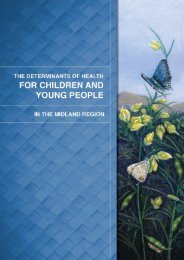Project SPLICE - Taranaki District Health Board
Project SPLICE - Taranaki District Health Board
Project SPLICE - Taranaki District Health Board
Create successful ePaper yourself
Turn your PDF publications into a flip-book with our unique Google optimized e-Paper software.
<strong>Project</strong> <strong>SPLICE</strong> FINAL - February 2010<br />
14000<br />
12000<br />
69% increase, 65-74 age group<br />
66% increase, 75-84 age group<br />
47% increase, 85+ age group<br />
10000<br />
Population<br />
8000<br />
6000<br />
4000<br />
2000<br />
0<br />
65 to 74 75 to 84 85+ 65 to 74 75 to 84 85+<br />
2001 2021<br />
Figure 1: Predicted older population changes across the <strong>Taranaki</strong> region<br />
Whether the current orientation and distribution of services can manage this burgeoning<br />
population and the resulting increase in long term conditions is questionable and has been<br />
the focus of multiple guidelines [15-21] and reports [15, 16, 22-26] over the past ten years.<br />
Addressing capacity issues in secondary care and Aged Residential Care (ARC) is highly<br />
pertinent now and can only become more pressing with the changing age structure. Age<br />
related long term conditions are an area of focus given the change in demographics however<br />
the needs of younger people with chronic conditions such as type 1 diabetes, multiple<br />
sclerosis and cystic fibrosis also need to be considered.<br />
This picture is complicated for <strong>Taranaki</strong> as a result of the overall decline in population<br />
projected at a 9% drop from 2001 to 2026 (See appendix II). This overall decline in<br />
population means that <strong>Taranaki</strong> DHB will not on average obtain demographic increases in<br />
funding. Other <strong>District</strong>s in New Zealand which obtain demographic increases can target<br />
these specifically toward the management of long term conditions and support for the<br />
elderly. <strong>Taranaki</strong> will have similar increases in demand for these services but will need to<br />
achieve a shift in focus of existing services from the declining under 65 age group to older<br />
people with long term conditions. Balancing this challenge is the strength that is already<br />
evident in service provision in the <strong>Taranaki</strong> region. Current <strong>Health</strong> Targets directly relevant<br />
to management of long term conditions provide an indication of this with <strong>Taranaki</strong> DHB<br />
leading all other DHBs in performance against these targets in the first Quarter of 2009/10<br />
with an average achievement of 79% 2<br />
For an older person, primary care most often remains the key access point for health care.<br />
Redesign of primary care and the wider health system to support primary care activity offers<br />
the most viable means to address capacity concerns now and in the future. Indeed, New<br />
2<br />
Relevant health targets include: (a) an increased percent of the eligible adult population will have had their<br />
cardiovascular disease risk assessed in the last five years; (b) an increased percent of people with diabetes will attend<br />
free annual checks; and (c) an increased percent of people with diabetes will have satisfactory or better diabetes<br />
management.<br />
8 | P a g e

















